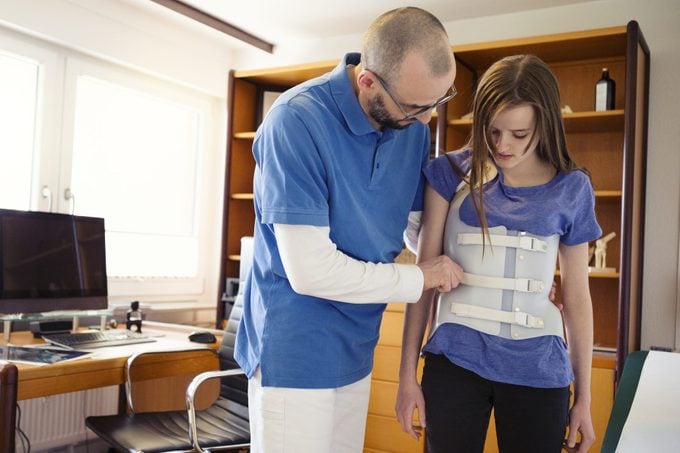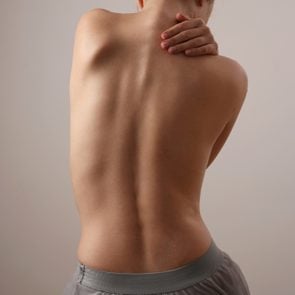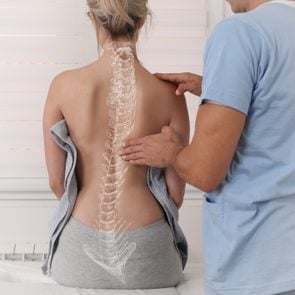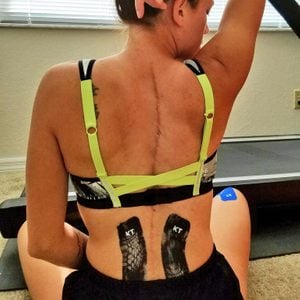7 Treatments Used to Help Correct Scoliosis
Updated: Jun. 10, 2021
Scoliosis seldom needs treatment, but in some cases, the curves grow more pronounced and need correction. Here are the scoliosis treatments that can help correct and treat a spinal curvature.
What is scoliosis?
Most of the time, we don’t pay too much attention to the shape of our back. Plain and simple, it’s relatively flat and straight up and down.
But if you have the spinal problem known as scoliosis, your spine curves in a different way than the average person’s.
The curve might veer to the left or right, giving your spine the look of the letter C. Or the curve might zigzag in both directions so your spine resemble an S.
When the curve measures more than 10 degrees, it is considered to be scoliosis.
According to the American Association of Neurological Surgeons, scoliosis affects 2 to 3 percent of the population, or about six to nine million people.
It occurs predominantly in children, developing before their bone growth is complete. Still, adolescents with scoliosis may continue to have it as an adult, or scoliosis may develop in the womb.
Even though scoliosis is a spinal abnormality, most cases are considered mild and almost never cause any issues or back pain.
What causes scoliosis?
It’s a common misconception that scoliosis is caused by poor posture, carrying heavy backpacks, or not drinking enough milk. Research has proven those to be myths.
The causes for most types of scoliosis are unknown. Some types stem from an underlying condition, such as muscular dystrophy or cerebral palsy, while others are from congenital issues that are present at birth.
What are the signs of scoliosis?
We all have slight curves in our spine, but a curvy spine in people with scoliosis might be slightly more apparent.
Adults and children may have one or more of the following scoliosis symptoms:
- The head isn’t centered between the shoulders or is slightly tilted to one side
- The body has a slight lean to one side
- One shoulder blade may bulge out more than the other
- One hip is higher than the other
- One side of the rib cage sets up higher than the other
- The waistline is uneven
- The skin texture over the spine may have hairy patches or dimples, and the skin may be slightly discolored
Adults may be more inclined to have symptoms associated with the natural aging process and disc degeneration. Those include:
- Low back pain and stiffness
- Fatigue from muscle strain on the back
- Pinched nerves that cause shooting pain in the legs, numbness, or cramping
Categories of scoliosis
There are three classifications into which the different forms of scoliosis fit:
- Idiopathic: No specific cause is identified (80 percent of scoliosis falls into this category)
- Congenital: Spinal deformities are apparent at birth
- Neurological: Scoliosis develops secondary to a neurological or muscular disease, such as cerebral palsy or muscular dystrophy
Treatment for scoliosis
After a physical examination (and possibly X-rays) confirms scoliosis, a doctor will measure the curves of the spine and tell you the degrees of curvature.
The curves may stabilize as the child grows, and it may not be noticeable or worsen.
Scoliosis hardly ever causes debilitating back pain or interferes with daily activities. Only in rare cases does scoliosis require surgery.
The treatment plan for your scoliosis depends on your age and the severity of the curves of your spine.
(Check out the best mattresses for scoliosis support.)
Observation
For people who are asymptomatic, have curves less than 25 degrees, or have stopped growing, observation is is the cornerstone of treatments. In this case, a doctor will simply keep tabs on the curvature.
Curves may stabilize and never need bracing or any form of treatment. You might visit the doctor as often as every four to six months to check if the curves have increased.
Eventually, scoliosis-related doctor visits may be reduced to yearly or every few years to ensure the curves don’t worsen into adulthood.

Scoliosis brace
Bracing is one of the most common treatments for scoliosis.
It is recommended for curves larger than 25 degrees but smaller than 45 to 50 degrees in someone who is still growing.
“The goal of bracing is to prevent the spinal curve from worsening. The ultimate goal is to avoid the need for surgery,” says Joseph P. Davey, MD, chief of pediatric orthopedics at the University of Oklahoma College of Medicine.
Bracing within this range isn’t necessarily a guarantee surgery won’t be needed. It depends on how much the spine is still growing.
Bracing has a better shot at helping to stabilize or impede more growth when scoliosis is detected while the bones are still growing.
Once a person reaches skeletal maturity, a scoliosis brace is ineffective. But a scoliosis back brace may be worn for comfort or help achieve a better sitting position.
Types of braces
Hard plastic braces have been shown to be the most effective and are preferred by most spine surgeons.
“The landmark Bracing in Adolescent Idiopathic Scoliosis Trial definitively showed the benefit of plastic braces and that a minimum of 13 hours is required to be better than no brace,” says Walter Truong, MD, a pediatric orthopedic surgeon at Gillette Children’s Specialty Healthcare in St. Paul, Minnesota.
Interestingly, logging in more hours wearing the brace may not have added benefit, according to the study.
Soft braces are more comfortable and have shown some success for very mild curves of 15 to 35 degrees.
That said, studies on these braces included participants with curves that generally remain stable without treatment. So the effectiveness of soft braces is questionable, Dr. Truong says.
There are nighttime-only braces that have shown limited success in certain curve types and in more mature patients that are still growing, according to a systematic review in Spine Deformity.
They are only worn during sleep because they aren’t comfortable to wear while moving about during daily activities.
Wearing a brace at nighttime is more appealing, so the compliance is higher, but more research is needed to determine if they are as good as braces worn for 18 hours a day.
Wearing the brace
A doctor will provide specific instructions for wearing the brace, but your child will likely wear it for several hours each day.
Braces are removed for bathing, swimming, and certain sports. Generally speaking, your child can wear it to play most sports or during physical activities.
Still, wearing a brace can feel cumbersome, and kids sometimes feel self-conscious about wearing it.
Counseling for parents and children can go a long way to supporting and motivating kids to wear the brace.
Dr. Truong says things like heat sensors in the brace and acknowledging the child’s wear time has been shown to increase adherence. Creative expression helps too.
“Allowing patients to have artistic designs on their braces and connecting them with others who have gone through the same treatment can be helpful,” says Dr. Truong.
Girls can connect with other brace-wearing girls at the site Curvy Girls (progressive curvature of the spine is more prevalent in girls), and anyone can check out the online community forums at the National Scoliosis Foundation.
Physical therapy
Physical therapy is the mainstay treatment for almost anyone with scoliosis, particularly people with neuromuscular scoliosis or kids with early onset scoliosis.
Physical therapy can help treat underlying diseases, such as cerebral palsy or muscular dystrophy, when scoliosis is present.
“Physical therapy is often a part of scoliosis treatment,” says Dr. Davey. “If a patient’s scoliosis is painful, they will often work with a physical therapist to help resolve the pain,.”
These are the types of physical therapy commonly used:
Range-of-motion exercises
“This is the foundation for treating scoliosis and/or the treatment of joints [vertebrae] with limitations,” says Marzelle Black, physical therapist at UCHealth Pikes Peak Regional Hospital in Woodland Park, Colorado.
This method essentially stretches and lengthens the affected side of the curvature by using active (patient-controlled) motion or hands-on assistance from the physical therapist to achieve full available motion.
“Range of motion will aid in normalizing the spine to a more neutral position and therefore decrease the visual curvatures—the S or C shape,” says Black.
Manual therapy
“Manual therapy is used to assist in the further mobilization of the limited motion in the vertebrae and to improve/increase the motion to normalize the alignment and functional movement of the spine,” says Black.
In other words, manual therapy helps the spine gain greater range of motion and movement, and works to improve alignment.
Physical therapists typically use their own hands to gently restore motion to joints and muscle tissues that may have become restricted due to scoliosis.
Strength training
The abnormal curvatures in scoliosis can affect muscle function, with one side overworked and one side weaker, creating an imbalance.
“Strengthening exercises address both problems in the ultimate goal to achieve muscle symmetry,” says Black.
Schroth Method
“The Schroth Method is one of several types of spine-specific exercises and body awareness training programs that help patients appreciate the curves and coinciding rotation of the spine and rib cage,” says Dr. Truong.
This method can be used with any age range but is generally more successful with younger patients and those getting treatment after an early diagnosis.
Patients are trained to use their own muscles to adjust their spine and chest wall to hold the spine in a better position.
“I explain to my patients that it is like teaching your body to do what the brace does, but without the brace being there,” Dr. Truong says.
Most centers are using spine-specific exercises in conjunction with spine bracing rather than in isolation.
More research is needed to determine whether spine-specific exercises are better than no treatment, long term, Dr. Truong says.
There is clear evidence that these exercises reduce back pain. “Though most patients with scoliosis do not complain of back pain,” he adds.
Casting
Casting is often used in infants and toddlers to try and correct scoliosis because they are too young for—or may not need—surgery.
Plus, it’s challenging to make a brace that fits a small child. Gentle traction via the cast can help correct the curve. A soft liner and padding under the cast protect the skin, and a hole in the cast allows the stomach to expand for eating and breathing.
This procedure is done under general anesthesia, as the child needs to be perfectly still.
In 30 to 50 percent of cases, it completely corrects the curvature, but it’s crucial to start casting early.
“Results are best when started before age 18 months,” says Sumeet Garg, MD, a pediatric orthopedic and spine surgeon and associate professor of orthopedics at the University of Colorado.
Typically, the casts need to be replaced every eight weeks or so, depending on the child’s growth.
Halo gravity traction
Some children with severe scoliosis may have curves that pinch the spinal cord or cause compression in the spine, making it difficult to breathe easily.
A halo—or metal ring—surrounds the head and connects to a pulley system on the child’s bed, walker, and wheelchair. Gentle traction helps elongate the spine and stretch out soft tissue.
“It is used for severe curvatures—usually in preparation for surgery to reduce the curvature prior to an operation,” says Dr. Garg.
Wearing the halo isn’t painful, but children need to stay in the hospital while wearing it.
Depending on the severity of the curvature, that might mean a hospital stay of three to eight weeks.
Alternative treatments
“Pilates can help improve your core strength and flexibility,” says Dr. Davey. “This is very good for the back and can help with the pain. We do think it affects the progression of scoliosis.”
Yoga, chiropractor care, and massage therapy may help alleviate discomfort and back pain, but they won’t change curvature.
Scoliosis surgery
Scoliosis surgery is reserved for people with curves greater than 45 to 50 degrees and/or those who are at risk for worsening once the growth cycle is complete.
“Forms of surgery include decompression of nerves that can become pinched in areas of arthritic buildup or structural collapse, focal reconstruction of structurally failed areas, and complex reconstructions with correction of the scoliotic curves through realignment and fusion,” explains Robert K. Eastlack, MD, an orthopedist with Scripps Memorial Hospital, Scripps Green Hospital, and Scripps Mercy Hospital in La Jolla, California.
That’s a lot of medical terms. It can seem overwhelming, but your doctor will discuss the options that are most relevant to you or your child.
Spinal fusion
Of the surgeries available, spinal fusion is the gold standard for treatment in patients who have reached skeletal maturity.
“Spinal fusion is best thought of as a preventative surgery. The primary goal is to prevent long-term adverse effects related to progressive and severe scoliosis, which may include a higher incidence and severity of back pain, worsened pulmonary function, and adverse cosmesis,” explains Daniel Miller, MD, pediatric orthopedic surgeon at Gillette Children’s Specialty Healthcare in St. Paul, Minnesota. (Cosmesis is the physical appearance.)
If patients had back pain before surgery, some might have less pain after surgery.
Surgery in children who are still growing isn’t as straightforward because, in addition to stopping the curve’s progression, doctors must take future growth into consideration.
Will your child need surgery?
Surgery is seldom needed for any type of scoliosis.
Scoliosis-specific surgery is an even rarer treatment for those with neuromuscular scoliosis or for older adults with degenerative scoliosis.
Surgery is a riskier prospect in older people who have degenerative scoliosis and in those with an underlying condition or disease associated with neuromuscular scoliosis.
Next, here are the things people with scoliosis wish you knew.



